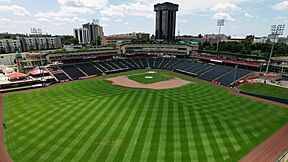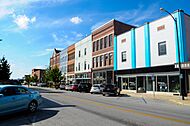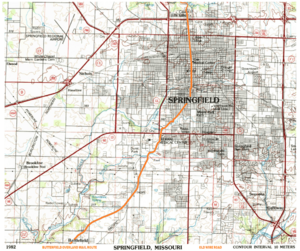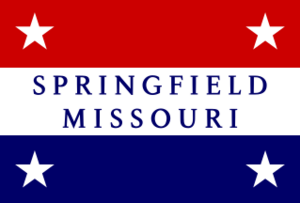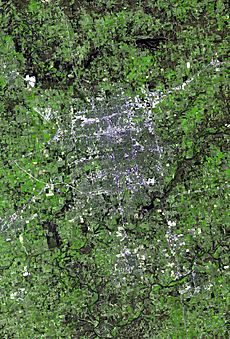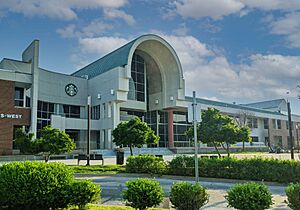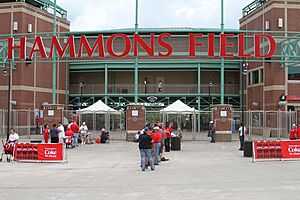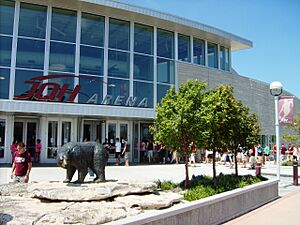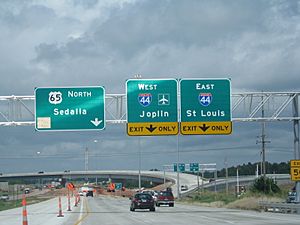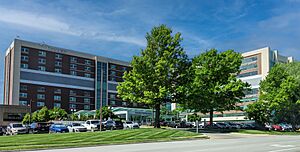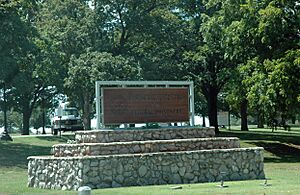Springfield, Missouri facts for kids
Quick facts for kids
Springfield, Missouri
|
|||
|---|---|---|---|
|
Hammons Field and Downtown Springfield
Park Central Square
Commercial Street
|
|||
|
|||
| Nickname(s):
The "Queen City of the Ozarks"
"Birthplace of Route 66" |
|||
| Country | |||
| State | |||
| Counties | Greene, Christian | ||
| Founded | 1834 | ||
| Incorporated | 1838 | ||
| Government | |||
| • Type | Council–manager | ||
| Area | |||
| • City | 83.70 sq mi (216.78 km2) | ||
| • Land | 83.11 sq mi (215.26 km2) | ||
| • Water | 0.59 sq mi (1.52 km2) | ||
| • Metro | 3,021 sq mi (7,824 km2) | ||
| Elevation | 1,299 ft (396 m) | ||
| Population
(2020)
|
|||
| • City | 169,176 | ||
| • Estimate
(2023)
|
170,188 | ||
| • Rank | US: 152nd | ||
| • Density | 2,035.49/sq mi (785.91/km2) | ||
| • Urban | 282,651 (US: 143rd) | ||
| • Urban density | 2,104.1/sq mi (812.4/km2) | ||
| • Metro | 475,432 (US: 111th) | ||
| Demonym(s) | Springfieldian | ||
| Time zone | UTC−6 (CST) | ||
| • Summer (DST) | UTC−5 (CDT) | ||
| ZIP codes |
65801-65810, 65814, 65817, 65890, 65897-65899
|
||
| Area code(s) | 417 | ||
| FIPS code | 29-70000 | ||
| GNIS feature ID | 0735864 | ||
| Website | springfieldmo.gov | ||
Springfield is a city in the state of Missouri, USA. It is the third largest city in Missouri. In 2020, about 169,176 people lived there. Springfield is the main city of a larger area called the Springfield metropolitan area. This area had about 487,061 people in 2022. The city is located on the Ozarks plateau, which has rolling hills.
Springfield has a few nicknames. People call it the "Queen City of the Ozarks." It is also known as the "Birthplace of Route 66." The city is home to the main offices of Bass Pro Shops and the Wonders of Wildlife Museum & Aquarium. O'Reilly Auto Parts also started here. Springfield is close to Wilson's Creek National Battlefield and the historic Trail of Tears. The city is a major center for medical care. Its two largest hospitals, CoxHealth and Mercy, are the biggest employers. Springfield also has several universities, like Missouri State University and Drury University.
Contents
- What's in a Name?
- A Look Back in Time
- City Layout and Nature
- People and Neighborhoods
- How Springfield Works
- Learning and Schools
- Fun and Recreation
- Arts and Events
- Sports in Springfield
- Getting Around Springfield
- Health Care
- Media and Entertainment
- Famous People from Springfield
- Sister Cities
- See also
What's in a Name?
The exact reason for Springfield's name is not fully clear. Many people believe it was named by settlers from Springfield, Massachusetts. One story says that James Wilson, an early settler, offered free whiskey to anyone who would vote for the name Springfield. He named it after his hometown in Massachusetts.
Another idea comes from an old newspaper editor, J. G. Newbill. In 1881, he wrote that the name came from Kindred Rose. Rose suggested "Springfield" to honor his hometown, Springfield, Tennessee. A historian named R. I. Holcombe wrote in 1883 that the name came from a "spring" under a hill and a "field" on top of the hill. This is where the main part of the town was located.
A Look Back in Time
The land that is now Missouri became part of the United States in 1803. This was through the Louisiana Purchase. Soon after, Delaware Native Americans received land here. The Kickapoo also built homes on a nearby prairie. Missouri became a state in 1821. In 1833, the area became Greene County. It was named after General Nathanael Greene from the American Revolutionary War. John Polk Campbell, who founded Springfield, helped make this happen. Springfield was officially founded in 1830 and became an official city in 1838.
Early Roads and Trails
In 1838, the Cherokee people were forced to leave their homes. This journey is known as the Trail of Tears. It passed through the Springfield area. Today, you can find parts of this historic route.
An old road, once called the Military Road, connected Springfield to Fort Smith, Arkansas. By 1858, the Butterfield Overland Mail stagecoach used this road. It carried people to California. Later, the first telegraph line was put along this road. This is why it became known as the Telegraph or Wire Road. This road was very important during the American Civil War. You can still see parts of it at Wilson's Creek National Battlefield.
The Railroad Arrives
Railroads brought new businesses and factories to Springfield. The St. Louis and San Francisco Railway, also known as the Frisco, set up its main offices here. Springfield became a busy crossroads for trains. Today, you can still see trains from the Jefferson Avenue Footbridge.
Springfield in the Civil War
During the American Civil War, Missouri was a border state. This meant people in Springfield had different ideas about the war. On August 10, 1861, a big battle happened near Springfield. It was called the Battle of Wilson's Creek. This was the first major fight west of the Mississippi River. Union General Nathaniel Lyon was killed there.
Later, on October 25, 1861, the First Battle of Springfield took place. The Union army won this battle. For the next year, the city was sometimes controlled by Union forces and sometimes by Confederate forces. On January 8, 1863, the Second Battle of Springfield happened. After this, Springfield stayed under Union control until the war ended.
After the war, the Springfield National Cemetery was created. Soldiers from both sides were buried there. In 1960, Wilson's Creek National Battlefield was made a national park. It helps remember the important battle that happened there.
Wild West History
On July 21, 1865, a famous "quick draw" duel happened in Springfield's town square. It was between Wild Bill Hickok and Davis Tutt. This event helped create the image of the Wild West. You can find small markers on Park Central Square that show where Hickok and Tutt stood.
Birthplace of Route 66
Springfield is known as the "Birthplace of US Route 66." On April 30, 1926, officials first suggested the name for this new highway. It would connect Chicago to Los Angeles.
John T. Woodruff from Springfield became the first president of the U.S. Highway 66 Association. Their goal was to pave the entire highway and encourage tourism. By 1938, Route 66 was the first fully paved highway in America. It became known as the "Mother Road."
You can still see parts of the old Route 66 in Downtown Springfield. Places like Red's Giant Hamburg, which is said to have the first drive-up window, were along this famous road.
City Layout and Nature
Springfield is located on the Ozarks plateau. The city covers about 81.72 square miles of land. It is mostly flat with some rolling hills and cliffs. Many streams and rivers flow through or near the city, like the James River. There are also several lakes nearby, such as Table Rock Lake and Fellows Lake.
Weather and Climate
Springfield has four clear seasons. It can be very humid, especially in late summer. The average temperature changes from about 32.6°F (0.3°C) in January to 78.2°F (25.7°C) in July. The city gets about 45.6 inches (116 cm) of rain each year. It also gets about 17.0 inches (43 cm) of snow.
According to a 2007 Forbes magazine story, Springfield has the most varied weather in the United States. This means the weather can change a lot, even overnight!
| Climate data for Springfield–Branson National Airport, Missouri (1981−2010 normals, extremes 1888−present ) | |||||||||||||
|---|---|---|---|---|---|---|---|---|---|---|---|---|---|
| Month | Jan | Feb | Mar | Apr | May | Jun | Jul | Aug | Sep | Oct | Nov | Dec | Year |
| Record high °F (°C) | 76 (24) |
84 (29) |
92 (33) |
93 (34) |
95 (35) |
101 (38) |
113 (45) |
108 (42) |
104 (40) |
93 (34) |
83 (28) |
77 (25) |
113 (45) |
| Mean maximum °F (°C) | 65.6 (18.7) |
71.1 (21.7) |
78.8 (26.0) |
83.7 (28.7) |
86.9 (30.5) |
92.4 (33.6) |
96.9 (36.1) |
98.2 (36.8) |
92.3 (33.5) |
84.2 (29.0) |
75.0 (23.9) |
66.3 (19.1) |
99.6 (37.6) |
| Mean daily maximum °F (°C) | 42.9 (6.1) |
48.2 (9.0) |
57.5 (14.2) |
67.2 (19.6) |
75.3 (24.1) |
83.8 (28.8) |
88.8 (31.6) |
89.0 (31.7) |
80.3 (26.8) |
69.0 (20.6) |
56.7 (13.7) |
44.9 (7.2) |
67.1 (19.5) |
| Mean daily minimum °F (°C) | 22.4 (−5.3) |
26.1 (−3.3) |
35.2 (1.8) |
44.3 (6.8) |
54.4 (12.4) |
63.1 (17.3) |
67.6 (19.8) |
66.6 (19.2) |
57.7 (14.3) |
46.5 (8.1) |
35.4 (1.9) |
25.0 (−3.9) |
45.5 (7.5) |
| Mean minimum °F (°C) | 3.0 (−16.1) |
7.2 (−13.8) |
16.3 (−8.7) |
27.8 (−2.3) |
39.3 (4.1) |
50.2 (10.1) |
57.1 (13.9) |
54.6 (12.6) |
40.0 (4.4) |
29.4 (−1.4) |
18.4 (−7.6) |
5.0 (−15.0) |
−3 (−19) |
| Record low °F (°C) | −19 (−28) |
−29 (−34) |
−8 (−22) |
16 (−9) |
29 (−2) |
42 (6) |
44 (7) |
44 (7) |
30 (−1) |
18 (−8) |
4 (−16) |
−16 (−27) |
−29 (−34) |
| Average precipitation inches (mm) | 2.47 (63) |
2.52 (64) |
3.62 (92) |
4.32 (110) |
5.10 (130) |
4.85 (123) |
3.68 (93) |
3.55 (90) |
4.61 (117) |
3.59 (91) |
4.22 (107) |
3.04 (77) |
45.57 (1,157) |
| Average snowfall inches (cm) | 5.4 (14) |
3.6 (9.1) |
2.4 (6.1) |
trace | 0 (0) |
0 (0) |
0 (0) |
0 (0) |
0 (0) |
trace | 0.7 (1.8) |
4.9 (12) |
17.0 (43) |
| Average precipitation days (≥ 0.01 in) | 8.2 | 7.8 | 10.5 | 10.5 | 12.0 | 10.6 | 8.4 | 7.9 | 7.6 | 9.5 | 9.4 | 8.9 | 111.3 |
| Average snowy days (≥ 0.1 in) | 3.5 | 2.9 | 1.4 | 0.1 | 0 | 0 | 0 | 0 | 0 | 0.1 | 0.7 | 2.8 | 11.5 |
| Average relative humidity (%) | 68.3 | 68.5 | 65.2 | 64.5 | 70.7 | 72.3 | 70.4 | 69.5 | 72.9 | 68.2 | 69.6 | 70.9 | 69.3 |
| Mean monthly sunshine hours | 167.6 | 157.4 | 208.7 | 236.4 | 268.0 | 282.7 | 321.6 | 292.1 | 237.6 | 217.3 | 155.1 | 145.9 | 2,690.4 |
| Percent possible sunshine | 54 | 52 | 56 | 60 | 61 | 64 | 72 | 70 | 64 | 62 | 51 | 49 | 60 |
| Source: NOAA (relative humidity and sun 1961−1990) | |||||||||||||
People and Neighborhoods
Springfield is home to many people. In 2020, about 169,176 people lived in the city. Most residents are White, with smaller groups of African American, Asian, and other races. About 6% of the population is Hispanic or Latino. The average age in the city is about 33.6 years old.
Springfield has many different neighborhoods. Some well-known ones include University Heights, Phelps Grove, and Rountree. There are also many other smaller community groups.
How Springfield Works
Springfield's economy relies on several key areas. These include health care, manufacturing, retail, education, and tourism. In 2021, the city's total economic output was about $19.49 billion.
Many people visit Springfield each year. The city has over 60 hotels and 6,000 hotel rooms. Major companies like Positronic, Bass Pro Shops, and O'Reilly Auto Parts have their main offices here. Two large Christian groups, the General Council of the Assemblies of God in the United States of America and Baptist Bible Fellowship International, also have their headquarters in Springfield.
The biggest employers in the Springfield area include:
| # | Employer | Employees |
|---|---|---|
| 1 | CoxHealth | 11,669 |
| 2 | Mercy Health System | 10,950 |
| 3 | Walmart | 5,372 |
| 4 | Springfield Public Schools | 4,100 |
| 5 | State of Missouri | 4,018 |
| 6 | Bass Pro Shops/Tracker Marine | 3,341 |
| 7 | United States Government | 3,005 |
| 8 | Missouri State University | 2,874 |
| 9 | Jack Henry & Associates | 2,174 |
| 10 | O'Reilly Auto Parts | 2,042 |
| 11 | Citizens Memorial Healthcare | 1,900 |
| 12 | City of Springfield | 1,655 |
| 13 | Ozarks Technical Community College | 1,554 |
| 14 | EFCO | 1,550 |
| 15 | SRC Holdings | 1,435 |
Learning and Schools
Springfield has many schools, from elementary to universities.
Universities
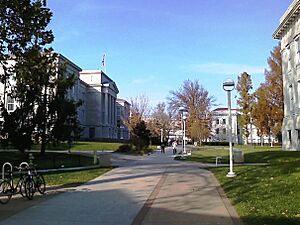
Missouri State University (MSU) is the second largest university in Missouri. It was founded in 1905 and has over 23,000 students.
Drury University is a private university. It was founded in 1873 and has over 1,000 students.
Evangel University is another private university. It was founded in 1955.
The University of Missouri also has a medical campus in Springfield. Other colleges include Mercy College of Nursing and Health Sciences.
Colleges
Ozarks Technical Community College (OTC) is the second largest college in Springfield. It has more than 11,000 students.
Other colleges in Springfield are Mission University and Cox College.
K-12 Schools
The Springfield Public School District is the largest in Missouri. Public high schools include Central High School, Kickapoo High School, and Glendale High School.
Some parts of Springfield are in other school districts. These include Willard R-II School District and Republic R-III School District.
There are also private high schools like Springfield Sudbury School and Springfield Catholic High School.
Fun and Recreation
The Springfield-Greene County Park Board manages many parks and sites. These include the Nathanael Greene/Close Memorial Park. This park has a Japanese Stroll Garden and a Native Butterfly House. Other fun places are the Mediacom Ice Park and the Dickerson Park Zoo.
Ozark Greenways Inc. helps create trails for walking and biking. The Frisco Highline Trail is a 35-mile trail that connects Springfield to Bolivar.
The Missouri Department of Conservation runs the Springfield Nature Center. The National Park Service manages the nearby Wilson's Creek National Battlefield.
Springfield is close to many natural places. You can visit lakes like Table Rock Lake and Lake Springfield. There are also caves like Fantastic Caverns and forests like Busiek State Forest.
Arts and Events
Springfield's downtown area has been updated. Many old buildings are now lofts, restaurants, and shops. Historic theaters like the Gillioz Theatre and the Landers Theatre have been restored.
The Creamery Arts Center opened in 2001. It has art galleries, studios, and classrooms for art workshops.
Springfield is famous for its local version of cashew chicken. It's a very popular dish in the city.
Cultural Groups
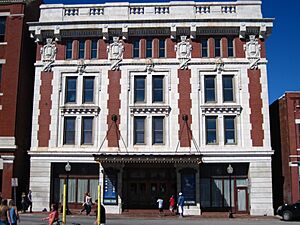
The Ozarks Lyric Opera performs many well-known shows. The Springfield Ballet brings ballet performances to the area.
The Springfield Little Theatre was founded in 1934. It is the oldest civic theater in Missouri. It performs at the Landers Theatre. The Springfield Symphony is also one of the city's oldest arts groups. It performs monthly at Missouri State University.
The Springfield Art Museum started in 1928. It shows many art exhibitions. The GLO Center is a community center for the LGBTQIA+ community in the Ozarks.
In 2022, Springfield adopted a new city flag. It was designed to better represent the city's unique history and identity.
Fun Events
The Missouri Food Truck Festival brings many food trucks to Springfield. It also has live music.
First Friday is a monthly event downtown. Local artists show their work in galleries.
Cider Days is a two-day event on Walnut Street. It features local crafts, fall activities, and cider tasting. Arts Fest is another similar event in May.
Since 2010, Springfield has hosted the annual Birthplace of Route 66 Festival. It includes a parade of vintage cars and live music. People can also see classic cars and buy Route 66 art.
The Japanese Fall Festival happens in September. It celebrates Japanese culture with visitors from Springfield's sister city, Isesaki, Japan.
Springfield also has many holiday events. These include a Downtown Christmas Parade and a yearly Christmas tree lighting.
Places to Visit
|
|
Sports in Springfield
Springfield is home to college sports teams from Missouri State University (NCAA Division I), Drury University (NCAA Division II), and Evangel University (NAIA). Large arenas like Great Southern Bank Arena and the O'Reilly Family Event Center host basketball games.
The Springfield Cardinals are a Double-A baseball team. They are part of the St. Louis Cardinals and play at Hammons Field. Many players from the Springfield Cardinals have gone on to play for St. Louis.
The Springfield Rugby Football Club (SRFC) was started in 1983. They have teams for men, women, and youth.
Springfield hosts the PGA-sponsored Price Cutter Charity Championship each year. This golf event raises money for local children's charities.
Springfield has hosted many sporting events. These include the Missouri Special Olympics and the Show-Me Games. The city also hosts the NAIA Softball Championship World Series.
The Missouri Sports Hall of Fame is located in Springfield. It has over four thousand sports items and exhibits. Each year, new members are added to honor people who have helped sports in Missouri.
Springfield was once part of the US Olympic Committee's Olympic Development Program. This program helped young athletes become top athletes. Today, the city continues a similar program called the Community Sports Development Program.
In 2023, Springfield announced a new indoor football team, the Ozarks Lunkers. They will play in The Arena League starting in 2024.
Sports Teams in Springfield
| Club | League | Sport | Venue | Established | Championships |
|---|---|---|---|---|---|
| Springfield Cardinals | Texas League | Baseball | Hammons Field | 2005 | 1 |
| Springfield Lasers | WTT | Team tennis | Cooper Tennis Complex | 1996 | 1 |
|
Demize NPSL |
NPSL | Soccer | Cooper Stadium | 2014 | 0 |
| Ozarks Lunkers | The Arena League | Arena Football | Wilson Logistics Arena | 2024 | 0 |
Getting Around Springfield
Highways
I-44 connects Springfield to St. Louis and Tulsa, Oklahoma. Route 13 goes north towards Kansas City. Other important roads are US 60, US 65, and US 160. The average time people spend commuting to work is about 17.7 minutes.
Springfield has the first diverging diamond interchange in the United States. This is a special type of road intersection. It is located where I-44 meets MO-13.
Historic US 66 used to pass through Springfield. You can still see parts of it in the city. There are plans to upgrade parts of US 60 and US 65 to possibly become an Interstate highway.
Airport
The Springfield-Branson National Airport serves the city. It has direct flights to 14 different cities. This airport is the main way people fly into the Springfield area. A new passenger terminal opened in 2009. It has 10 gates and lots of parking.
Trains
Passenger trains have not served Springfield since 1967. However, more than 65 freight trains travel through the city every day. Springfield used to be the main office for the St. Louis-San Francisco Railroad (Frisco). This railroad was later bought by Burlington Northern. Today, Burlington Northern Santa Fe (BNSF) Railway operates in Springfield.
Buses
City Utilities of Springfield runs the local bus service. Greyhound Lines and Jefferson Lines also have bus routes that stop in Springfield.
Health Care
Springfield is a major center for medical care. Many people in the city work in health care. The main hospitals are CoxHealth and Mercy. Mercy is considered one of the top 100 hospitals in the country. Over 30,000 people in the Springfield area work in health care.
CoxHealth is a private health care system. It is ranked among the top hospitals in Missouri. CoxHealth has six hospitals and many clinics. Cox South is a major trauma and stroke center. Cox also has a Children's Miracle Network Hospital for kids.
Mercy Hospital Springfield is part of the Mercy Health System. It is also a top hospital and has a Level 1 Trauma Center. Mercy Springfield has a special pediatric cancer center. Both Cox and Mercy have Ronald McDonald House Charities to help families whose children are getting medical treatment.
The United States Medical Center for Federal Prisoners is also in Springfield. This facility helps federal inmates with their medical needs.
Media and Entertainment
Springfield's main daily newspaper is the Springfield News-Leader. It reaches over 50,000 people on Sundays. Other newspapers include Springfield Business Journal and The Standard, which is Missouri State University's student newspaper.
417 Magazine is a local magazine. It covers lifestyle and entertainment in the area. It also has 417 Biz for business news and 417 Bride for wedding information.
Television
Springfield has its own television market. This area includes 31 counties in Missouri and Arkansas.
| Station | Channel | Network | Subchannels |
|---|---|---|---|
| KYTV | 3 | NBC | 3.4 Circle
3.5 Justice Network 3.6 Quest |
| KRFT | 8 | Court TV | 8.2 Light TV
8.3 This TV 8.4 Heartland 8.5 QVC 8.6 Nuestra Visión 8..8 Dabl 8.9 Buzzr |
| KOLR | 10 | CBS | 10.2 Laff
10.3 Grit 10.4 CBN News |
| KYCW | 24 | The CW | 3.2 WeatherNation TV
3.3 Cozi TV |
| KOZK | 21 | PBS | 21.2 PBS Kids
21.3 Create 21.4 World Channel |
| KOZL | 27 | MyNetworkTV | 27.2 Court TV Mystery
27.3 Bounce TV |
| KSPR | 33 | ABC | 33.2 The CW
33.3 Antenna TV |
| KRBK | 49 | Fox | 49.2 MeTV
49.3 Movies! |
Radio
Springfield has many radio stations. They play different types of music and news.
|
|
|
Film
Springfield has been part of film and television since the 1950s. Some movies have had their premieres here. For example, The Winning Team (1952) premiered at the Gillioz Theatre. Famous people like Ronald Reagan and Harry S. Truman attended.
Springfield also hosted the country music TV show Ozark Jubilee.
The city hosts the SATO 48 film contest each spring. Filmmakers have 48 hours to create a short film. A new film festival called Rated SGF also started in 2018.
Famous People from Springfield
Sister Cities
Springfield has two sister cities. These are cities in other countries that Springfield shares a special friendship with.
| City | Subdivision | Country |
|---|---|---|
| Tlaquepaque | Jalisco | Mexico |
| Isesaki | Gunma Prefecture | Japan |
See also
 In Spanish: Springfield (Misuri) para niños
In Spanish: Springfield (Misuri) para niños


